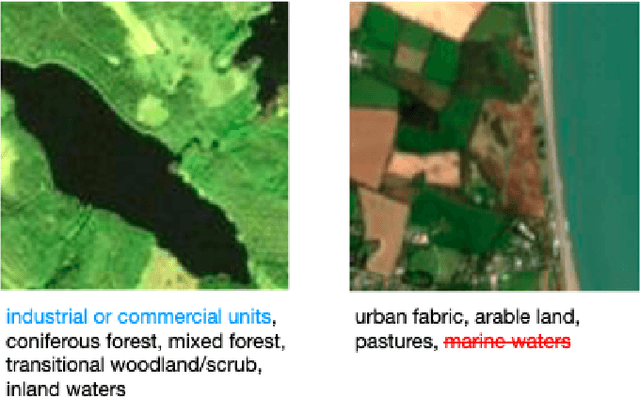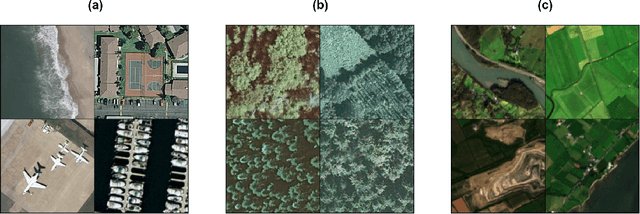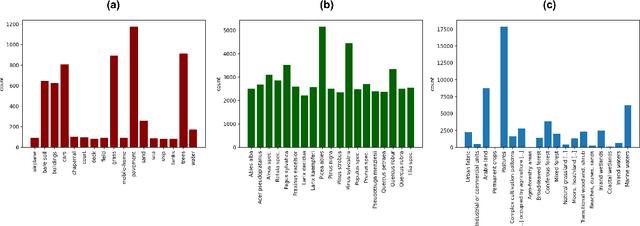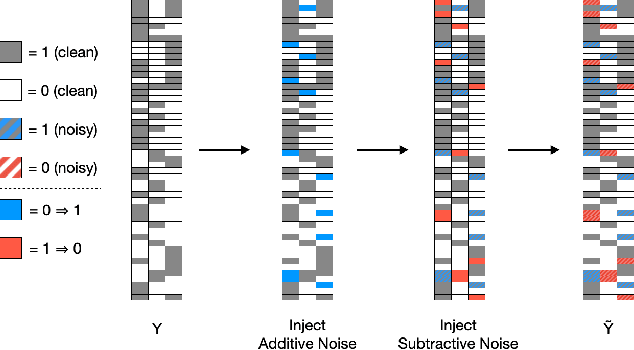Tom Burgert
CSMoE: An Efficient Remote Sensing Foundation Model with Soft Mixture-of-Experts
Sep 17, 2025Abstract:Self-supervised learning through masked autoencoders has attracted great attention for remote sensing (RS) foundation model (FM) development, enabling improved representation learning across diverse sensors and downstream tasks. However, existing RS FMs often either suffer from substantial computational complexity during both training and inference or exhibit limited representational capacity. These issues restrict their practical applicability in RS. To address this limitation, we propose an adaptation for enhancing the efficiency of RS FMs by integrating the Soft mixture-of-experts (MoE) mechanism into the FM. The integration of Soft MoEs into the FM allows modality-specific expert specialization alongside shared cross-sensor representation learning. To demonstrate the effectiveness of our adaptation, we apply it on the Cross-Sensor Masked Autoencoder (CSMAE) model, resulting in the Cross-Sensor Mixture-of-Experts (CSMoE) model. In addition, we introduce a thematic-climatic descriptor-driven sampling strategy for the construction of a representative and diverse training set to train our CSMoE model. Extensive experiments on scene classification, semantic segmentation, and content-based image retrieval demonstrate that our adaptation yields a reduction in computational requirements while maintaining or improving representational performance. Compared to state-of-the-art RS FMs, CSMoE achieves a superior trade-off between representational capacity, accuracy, and computational efficiency. On average, CSMoE achieves more than twice the computational efficiency of existing RS FMs, while maintaining competitive performance across all experiments. These results show the effectiveness of the proposed adaptation for creating computationally efficient RS FMs. The code for the model, the training set creation, and the model weights will be available at https://git.tu-berlin.de/rsim/csmoe.
reBEN: Refined BigEarthNet Dataset for Remote Sensing Image Analysis
Jul 04, 2024



Abstract:This paper presents refined BigEarthNet (reBEN) that is a large-scale, multi-modal remote sensing dataset constructed to support deep learning (DL) studies for remote sensing image analysis. The reBEN dataset consists of 549,488 pairs of Sentinel-1 and Sentinel-2 image patches. To construct reBEN, we initially consider the Sentinel-1 and Sentinel-2 tiles used to construct the BigEarthNet dataset and then divide them into patches of size 1200 m x 1200 m. We apply atmospheric correction to the Sentinel-2 patches using the latest version of the sen2cor tool, resulting in higher-quality patches compared to those present in BigEarthNet. Each patch is then associated with a pixel-level reference map and scene-level multi-labels. This makes reBEN suitable for pixel- and scene-based learning tasks. The labels are derived from the most recent CORINE Land Cover (CLC) map of 2018 by utilizing the 19-class nomenclature as in BigEarthNet. The use of the most recent CLC map results in overcoming the label noise present in BigEarthNet. Furthermore, we introduce a new geographical-based split assignment algorithm that significantly reduces the spatial correlation among the train, validation, and test sets with respect to those present in BigEarthNet. This increases the reliability of the evaluation of DL models. To minimize the DL model training time, we introduce software tools that convert the reBEN dataset into a DL-optimized data format. In our experiments, we show the potential of reBEN for multi-modal multi-label image classification problems by considering several state-of-the-art DL models. The pre-trained model weights, associated code, and complete dataset are available at https://bigearth.net.
A Label Propagation Strategy for CutMix in Multi-Label Remote Sensing Image Classification
May 22, 2024



Abstract:The development of supervised deep learning-based methods for multi-label scene classification (MLC) is one of the prominent research directions in remote sensing (RS). Yet, collecting annotations for large RS image archives is time-consuming and costly. To address this issue, several data augmentation methods have been introduced in RS. Among others, the data augmentation technique CutMix, which combines parts of two existing training images to generate an augmented image, stands out as a particularly effective approach. However, the direct application of CutMix in RS MLC can lead to the erasure or addition of class labels (i.e., label noise) in the augmented (i.e., combined) training image. To address this problem, we introduce a label propagation (LP) strategy that allows the effective application of CutMix in the context of MLC problems in RS without being affected by label noise. To this end, our proposed LP strategy exploits pixel-level class positional information to update the multi-label of the augmented training image. We propose to access such class positional information from reference maps associated to each training image (e.g., thematic products) or from class explanation masks provided by an explanation method if no reference maps are available. Similarly to pairing two training images, our LP strategy carries out a pairing operation on the associated pixel-level class positional information to derive the updated multi-label for the augmented image. Experimental results show the effectiveness of our LP strategy in general and its robustness in the case of various simulated and real scenarios with noisy class positional information in particular.
Estimating Physical Information Consistency of Channel Data Augmentation for Remote Sensing Images
Mar 21, 2024

Abstract:The application of data augmentation for deep learning (DL) methods plays an important role in achieving state-of-the-art results in supervised, semi-supervised, and self-supervised image classification. In particular, channel transformations (e.g., solarize, grayscale, brightness adjustments) are integrated into data augmentation pipelines for remote sensing (RS) image classification tasks. However, contradicting beliefs exist about their proper applications to RS images. A common point of critique is that the application of channel augmentation techniques may lead to physically inconsistent spectral data (i.e., pixel signatures). To shed light on the open debate, we propose an approach to estimate whether a channel augmentation technique affects the physical information of RS images. To this end, the proposed approach estimates a score that measures the alignment of a pixel signature within a time series that can be naturally subject to deviations caused by factors such as acquisition conditions or phenological states of vegetation. We compare the scores associated with original and augmented pixel signatures to evaluate the physical consistency. Experimental results on a multi-label image classification task show that channel augmentations yielding a score that exceeds the expected deviation of original pixel signatures can not improve the performance of a baseline model trained without augmentation.
On the Effects of Different Types of Label Noise in Multi-Label Remote Sensing Image Classification
Jul 28, 2022



Abstract:The development of accurate methods for multi-label classification (MLC) of remote sensing (RS) images is one of the most important research topics in RS. To address MLC problems, the use of deep neural networks that require a high number of reliable training images annotated by multiple land-cover class labels (multi-labels) have been found popular in RS. However, collecting such annotations is time-consuming and costly. A common procedure to obtain annotations at zero labeling cost is to rely on thematic products or crowdsourced labels. As a drawback, these procedures come with the risk of label noise that can distort the learning process of the MLC algorithms. In the literature, most label noise robust methods are designed for single label classification (SLC) problems in computer vision (CV), where each image is annotated by a single label. Unlike SLC, label noise in MLC can be associated with: 1) subtractive label-noise (a land cover class label is not assigned to an image while that class is present in the image); 2) additive label-noise (a land cover class label is assigned to an image although that class is not present in the given image); and 3) mixed label-noise (a combination of both). In this paper, we investigate three different noise robust CV SLC methods and adapt them to be robust for multi-label noise scenarios in RS. During experiments we study the effects of different types of multi-label noise and evaluate the adapted methods rigorously. To this end, we also introduce a synthetic multi-label noise injection strategy that is more adequate to simulate operational scenarios compared to the uniform label noise injection strategy, in which the labels of absent and present classes are flipped at uniform probability. Further, we study the relevance of different evaluation metrics in MLC problems under noisy multi-labels.
 Add to Chrome
Add to Chrome Add to Firefox
Add to Firefox Add to Edge
Add to Edge